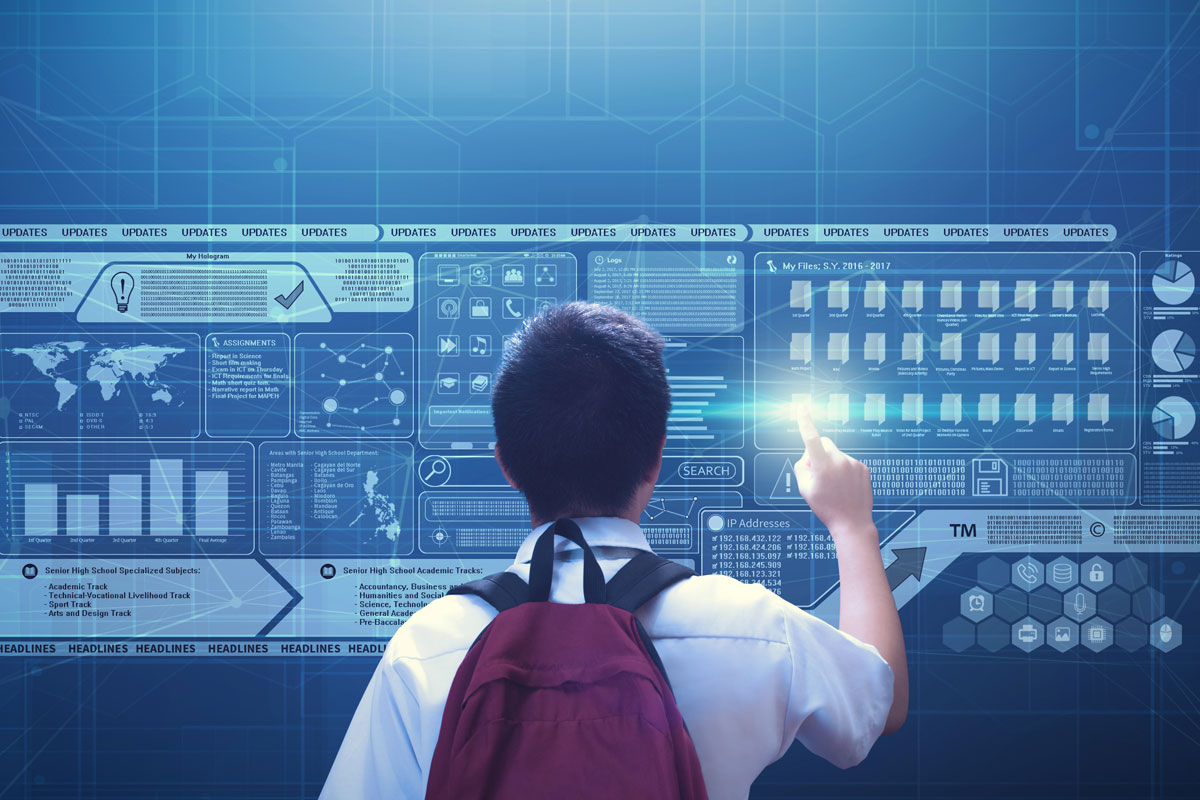
The Internet of Things (IoT) has dramatically changed the landscape of modern schools and education systems. From cost savings to specialized applications, students and educators are experiencing a radically different education system than 20 years ago. Intelligent whiteboards, custom applications, specialized lesson plans, and AI-enabled security systems are just a few ways advanced smart technology has infiltrated schools and classrooms.
On a simpler level, more students than ever have smartphones; the vast majority of teenagers (95%) 1 have a smartphone, and even 25% of kids 2 aged 6 to 10 have one. IoT in education is also expected to grow rapidly over the next few years, skyrocketing from $6.01 billion in 2021 to $17.42 billion in 2028 3. IoT technology is revolutionizing both the classroom and education with its device simplicity, increased cybersecurity, affordability and convenience, and the ability to create highly specialized applications. Let’s take a deeper look.
6 Ways Technology Is Making Schools Smarter
1. Improved Communication and Collaboration
When schools have intelligent whiteboards, tablets, and laptops, real-time communication and collaboration can happen across teachers, students, and parents when schools have smart whiteboards, tablets, and laptops. Especially across remote environments, all parties have more seamless communication and collaboration, providing more student support.
2. Increased Engagement
Teachers and administrators can seamlessly facilitate data-sharing to parents on a student’s learning style, progress, and areas of struggle. Parents can work on areas of improvement at home and stay abreast of student progress. Parents can also become more involved in school events.
3. Better Resouce Management
Resources like textbooks, learning materials, workbooks, and more are major components of education systems. With data-focused resource management systems, schools can better manage equipment across classrooms, laboratories, and athletic facilities.

4. Enhanced Security
Security is a hot-button issue for schools, and all parties involved are seeking more stringent and fail-safe security standards. Security cameras with advanced sensors and compute capability allow smart buildings with increased monitoring of grounds and facilities and a continuous record of who enters the school. Schools can leverage GPS systems to track school buses for their entire route, and IoT security systems with smart locks can effectively restrict access to certain people at certain times.
5. Increased Efficiency
Through IoT, teachers and administrators streamline many administrative tasks like attendance tracking and grading, freeing up their time to work with students one-on-one or develop a more advanced curriculum. Teachers can also automate many parent communications, saving time on one-off emails.
6. Cost Savings
Physical goods comprise a large majority of an average school budget, with schools spending roughly $1.6 billion on paper annually 4. Reusable technology like tablets completely eliminates paper costs while being more sustainable and eco-friendly. Cloud costs are also cheaper than physical storage, and thanks to increased flexibility via cloud services, data access, analysis, and storage are significantly more affordable and accessible.
Real-World IoT Applications in Education
SMART Boards
One of the first IoT applications that began popping up in schools, SMART boards are white interactive boards that project graphics, words, and illustrations for a more holistic learning experience. Another option is IPEVO, a wireless interactive whiteboard 5. More advanced interactive displays include Promethean 6, which offers the functionality of a whiteboard with cloud-based lesson delivery software along with personalized training for teachers. All of these work together to make lessons more dynamic and engaging.
Online Learning Management Systems
Companies like Bounce 7 and Blackboard 8 aggregate lesson plans, homework, quizzes, tests, grades, attendance, news, and communication in one centralized learning management system. Blackboard even goes a step further to personalize the educational experience with branded websites. These online systems are easy to access on different devices and help students take ownership of their classes.
Communication Hubs
For younger students, platforms like ClassDojo allow parents to see student schoolwork via photos and videos. ClassDojo is used in 95% of all US K-8 schools 9, facilitating easy-to-access and continuous communication with parents to increase students’ overall academic success.
Attendance Systems
Biometric systems like fingerprint attendance recorders can increase security and automate attendance data entry for students and administrators. Tools like identiMetrics can scan in 2 seconds with 100% accuracy 10.

Video Learning
As many students are learning remotely, video is an important component, and when audio and video are low-quality, cumbersome, and time-consuming, it creates a significant barrier. Kaltura 11 is a video management and creation tool that offers an intuitive interface for students and teachers to create high-quality videos. Teachers can provide personalized instruction over video, and students can quickly submit video work.
Studying Tools
Scanmarker 12 is a unique digital highlighter that allows students to quickly “highlight” text from physical resources and sync it right into their phone, tablet, or computer. Gradescope 13 helps students assess and grade each other’s work and discuss it. For college students, hi-tech school supplies like smart pens, smart notebooks, folding keyboards, and more help enhance the college experience.
Coding Tools
STEM-focused tools like LocoRobo14 and Quierum15 focus on robotics and science to teach coding languages like Python, C, Javascript, and MATLAB and master complex topics. As STEM jobs become more of a focus for high school and college students, earlier and earlier education in coding, computer science, and programming helps increase diversity and success in those fields.
How Ambiq Contributes
As IoT devices rapidly enhance the classroom, schools will look drastically different yet again in another decade. All of the devices that power the cost savings, increased flexibility and communication, video learning, and enhanced security will need optimal battery life and performance to deliver these results to students, parents, educators, and administrators. Ambiq® offers the most revolutionary system-on-chips (SoC) solutions in the market to make these innovations happen.
Resources
1 Most U.S. teens who use cellphones do it to pass time, connect with others, learn new things | August 2019
2 Age that kids acquire mobile phones not linked to well-being, says Stanford Medicine study | November 2022
3 Global IoT in Education Market – Industry Trends and Forecast to 2030 | June 2023
4 How Much Paper Schools Use & How Much It Costs Them | January 2020
5 IW2 Wireless Interactive Whiteboard System | 2023
6 Promethean – Interactive Displays and Software for Education | 2023
7 Hello – bounce | 2023
8 Blackboard | 2023
9 ClassDojo – Online Tools for Teaching & Learning | 2023
10 Biometric ID Management in K12 Schools | 2021
11 About – Kaltura | 2023
12 Scanmarker | 2023
13 Gradescope | 2023
14 Locorobo | 2023
15 Quierum | 2022


